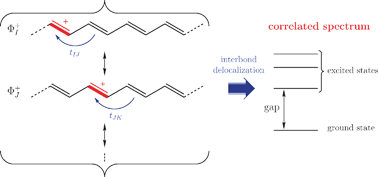A bottom-up valence bond derivation of excitation energies in 1D-like delocalized systems
Abstract
Using the chemically relevant parameters hopping integral

* Corresponding authors
a
Centre d'Investigació en Nanociència i Nanotecnologia (ICN-CSIC), UAB Campus, E-08193 Bellaterra, Spain
E-mail:
mikael.kepenekian@cin2.es
b
Laboratoire de Chimie Quantique, Institut de Chimie UMR 7177, CNRS and Université de Strasbourg, 4 rue Blaise Pascal, 67000 Strasbourg, France
E-mail:
vrobert@unistra.fr
c
Laboratoire de Physique Quantique, IRSAMC/UMR 5626, Université Paul Sabatier, 118 route de Narbonne, 31062 Toulouse Cedex 4, France
E-mail:
jean-paul.malrieu@irsamc.ups-tlse.fr
Using the chemically relevant parameters hopping integral

 Please wait while we load your content...
Something went wrong. Try again?
Please wait while we load your content...
Something went wrong. Try again?
M. Kepenekian, V. Robert, C. Boilleau and J. Malrieu, Phys. Chem. Chem. Phys., 2012, 14, 1381 DOI: 10.1039/C1CP23390D
To request permission to reproduce material from this article, please go to the Copyright Clearance Center request page.
If you are an author contributing to an RSC publication, you do not need to request permission provided correct acknowledgement is given.
If you are the author of this article, you do not need to request permission to reproduce figures and diagrams provided correct acknowledgement is given. If you want to reproduce the whole article in a third-party publication (excluding your thesis/dissertation for which permission is not required) please go to the Copyright Clearance Center request page.
Read more about how to correctly acknowledge RSC content.
 Fetching data from CrossRef.
Fetching data from CrossRef.
This may take some time to load.
Loading related content
